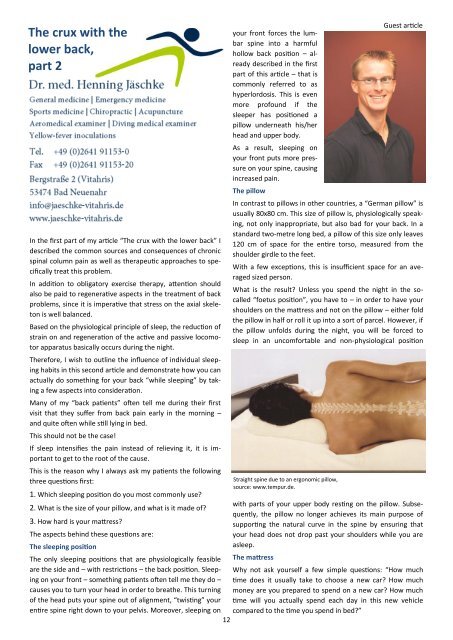effectively you can heat. MULTIBETON surface heating works with ...
effectively you can heat. MULTIBETON surface heating works with ...
effectively you can heat. MULTIBETON surface heating works with ...
You also want an ePaper? Increase the reach of your titles
YUMPU automatically turns print PDFs into web optimized ePapers that Google loves.
The crux <strong>with</strong> the<br />
lower back,<br />
part 2<br />
-<br />
-<br />
-<br />
In the first part of my article “The crux <strong>with</strong> the lower back” I<br />
described the common sources and consequences of chronic<br />
spinal column pain as well as therapeutic approaches to specifically<br />
treat this problem.<br />
In addition to obligatory exercise therapy, attention should<br />
also be paid to regenerative aspects in the treatment of back<br />
problems, since it is imperative that stress on the axial skeleton<br />
is well balanced.<br />
Based on the physiological principle of sleep, the reduction of<br />
strain on and regeneration of the active and passive locomotor<br />
apparatus basically occurs during the night.<br />
Therefore, I wish to outline the influence of individual sleeping<br />
habits in this second article and demonstrate how <strong>you</strong> <strong>can</strong><br />
actually do something for <strong>you</strong>r back “while sleeping” by taking<br />
a few aspects into consideration.<br />
Many of my “back patients” often tell me during their first<br />
visit that they suffer from back pain early in the morning –<br />
and quite often while still lying in bed.<br />
This should not be the case!<br />
If sleep intensifies the pain instead of relieving it, it is important<br />
to get to the root of the cause.<br />
This is the reason why I always ask my patients the following<br />
three questions first:<br />
1. Which sleeping position do <strong>you</strong> most commonly use?<br />
2. What is the size of <strong>you</strong>r pillow, and what is it made of?<br />
3. How hard is <strong>you</strong>r mattress?<br />
The aspects behind these questions are:<br />
The sleeping position<br />
-<br />
-<br />
<strong>you</strong>r front forces the lumbar<br />
spine into a harmful<br />
hollow back position – already<br />
described in the first<br />
part of this article – that is<br />
commonly referred to as<br />
hyperlordosis. This is even<br />
more profound if the<br />
sleeper has positioned a<br />
pillow underneath his/her<br />
head and upper body.<br />
As a result, sleeping on<br />
<strong>you</strong>r front puts more pressure<br />
on <strong>you</strong>r spine, causing<br />
increased pain.<br />
The pillow<br />
Guest article<br />
In contrast to pillows in other countries, a “German pillow” is<br />
usually 80x80 cm. This size of pillow is, physiologically speaking,<br />
not only inappropriate, but also bad for <strong>you</strong>r back. In a<br />
standard two-metre long bed, a pillow of this size only leaves<br />
120 cm of space for the entire torso, measured from the<br />
shoulder girdle to the feet.<br />
With a few exceptions, this is insufficient space for an averaged<br />
sized person.<br />
What is the result? Unless <strong>you</strong> spend the night in the socalled<br />
“foetus position”, <strong>you</strong> have to – in order to have <strong>you</strong>r<br />
shoulders on the mattress and not on the pillow – either fold<br />
the pillow in half or roll it up into a sort of parcel. However, if<br />
the pillow unfolds during the night, <strong>you</strong> will be forced to<br />
sleep in an uncomfortable and non-physiological position<br />
Straight spine due to an ergonomic pillow,<br />
source: www.tempur.de.<br />
<strong>with</strong> parts of <strong>you</strong>r upper body resting on the pillow. Subsequently,<br />
the pillow no longer achieves its main purpose of<br />
supporting the natural curve in the spine by ensuring that<br />
<strong>you</strong>r head does not drop past <strong>you</strong>r shoulders while <strong>you</strong> are<br />
asleep.<br />
The only sleeping positions that are physiologically feasible The mattress<br />
are the side and – <strong>with</strong> restrictions – the back position. Sleep- Why not ask <strong>you</strong>rself a few simple questions: “How much<br />
ing on <strong>you</strong>r front – something patients often tell me they do – time does it usually take to choose a new car? How much<br />
causes <strong>you</strong> to turn <strong>you</strong>r head in order to breathe. This turning money are <strong>you</strong> prepared to spend on a new car? How much<br />
of the head puts <strong>you</strong>r spine out of alignment, “twisting” <strong>you</strong>r time will <strong>you</strong> actually spend each day in this new vehicle<br />
entire spine right down to <strong>you</strong>r pelvis. Moreover, sleeping on<br />
12<br />
compared to the time <strong>you</strong> spend in bed?”










